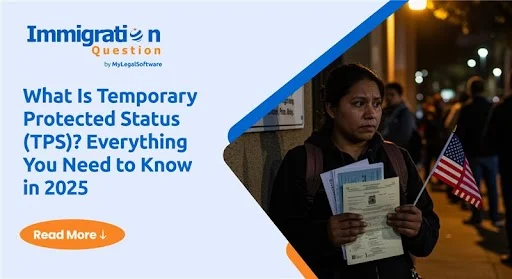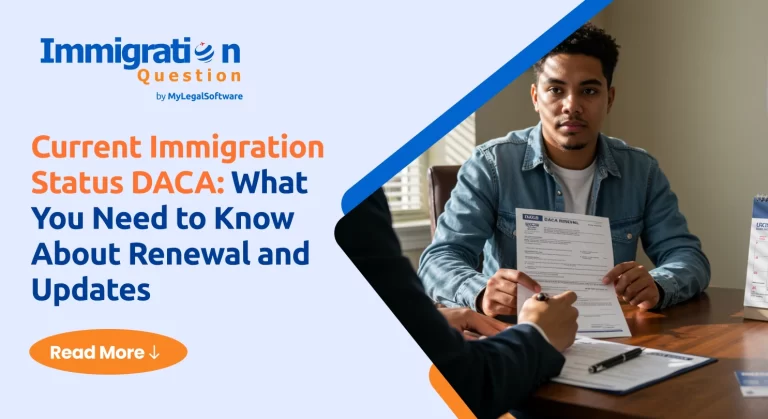If you’re living in the U.S. and your home country is facing war, natural disasters, or other extreme conditions, you may be eligible for Temporary Protected Status (TPS)—a humanitarian immigration benefit that provides safety, work authorization, and peace of mind.
As of 2025, TPS continues to be a critical lifeline for nationals from several countries around the world. But while it offers protection and work rights, it can be tricky to understand how TPS works and what it means for your long-term immigration journey.
In this guide, we’ll break it all down—what TPS is, who qualifies, how to apply, how to keep it current, and whether it can help you get a green card.
What is Temporary Protected Status (TPS)?
TPS is a temporary immigration benefit offered by the U.S. government to people from countries going through crises—like civil war, natural disasters, or other dangerous conditions.
The program was created under the Immigration Act of 1990, and it gives the Secretary of Homeland Security the authority to decide which countries qualify based on ongoing emergencies.
TPS immigration benefits include:
- Protection from deportation
- Eligibility for an Employment Authorization Document (EAD)
- Potential authorization for travel outside the United States
- TPS holders generally cannot be detained by DHS based solely on their lack of lawful immigration status, but they may be detained if there are other grounds for detention, such as criminal activity or security concerns.
It’s important to understand that TPS status is, by definition, temporary. It does not lead directly to lawful permanent resident status (green card) or citizenship. However, TPS holders may apply for other immigration benefits they qualify for while holding TPS.
Immigration can be confusing—don’t go through it alone. At Immigration Question, you’ll get fast answers from real immigration attorneys and connect with the right expert to guide you every step of the way.
Who Is Eligible for TPS?
To qualify for Temporary Protected Status, you must:
- Be a national of a TPS-designated country or have last lived in one if you don’t have a nationality
- File during the initial registration or re-registration period (or qualify for late initial filing)
- Have been physically present in the U.S. since the date set for your country
- Have no serious criminal convictions or immigration violations
Current TPS Countries in 2025
As of May 2025, the following countries have active TPS designations:
- Afghanistan
- Burma (Myanmar)
- Cameroon
- El Salvador
- Ethiopia
- Haiti
- Honduras
- Lebanon
- Nepal
- Nicaragua
- Somalia
- South Sudan
- Sudan
- Syria
- Ukraine
- Venezuela
- Yemen
This list is subject to change as the U.S. government regularly reviews and updates TPS designations. Always check the USCIS website for the most current information about TPS countries.
Grounds for Ineligibility
You may not be eligible for TPS if you:
- Have been convicted of any felony or two or more misdemeanors in the United States
- Are found inadmissible under applicable grounds in INA section 212(a), including non-waivable criminal and security-related grounds
- Are subject to any of the mandatory bars to asylum
- Fail to meet the continuous physical presence and continuous residence requirements
- Fail to register initially or to re-register without good cause
How to File a TPS Application
The process of applying for TPS involves several steps and forms. Here’s a breakdown of the TPS application process:
Initial Application
To apply for TPS for the first time, you need to submit:
1. Form I-821, Application for Temporary Protected Status
- Complete all sections accurately
- Include the appropriate filing fee or fee waiver request
- Provide evidence of identity and nationality
2. Form I-765, Application for Employment Authorization
- This is optional but required if you wish to obtain work authorization
- Include the appropriate filing fee or fee waiver request
3. Supporting Documentation
- Proof of identity and nationality (passport, birth certificate with photo ID, national identity document)
- Evidence of date of entry into the U.S.
- Evidence of continuous residence since the required date
- Passport-style photos
- Evidence supporting any requested fee waivers
Filing Deadlines
Initial applications for TPS must be filed during the designated registration period for your country. If you’re late, you must show good cause for late filing. Re-registration periods are announced in the Federal Register and usually last 60 days.
Common Reasons for Denial
TPS applications may be denied for various reasons, including:
- Missing the initial registration or re-registration deadline without good cause
- Lack of sufficient evidence of nationality or identity
- Criminal convictions that make you ineligible
- Failure to prove continuous physical presence or continuous residence
- Missing or incorrect paperwork
TPS Extension and Re-Registration
Once a country is designated for TPS, the Secretary of Homeland Security periodically reviews whether conditions in that country continue to meet the criteria for designation. Based on this review, TPS may be extended, redesignated, or terminated.
TPS Extension and Re-Registration
When DHS extends TPS for a country, it announces:
- The extension period (6, 12, or 18 months)
- The re-registration period (usually 60 days)
During a re-registration period, current TPS holders must:
- Submit Form I-821 without the initial registration fee (though a biometric services fee may apply)
- Submit Form I-765 if you want a work permit with the appropriate fee or fee waiver
- Submit evidence that you continue to meet eligibility requirements
Failure to re-register without good cause can result in the loss of TPS status. However, if you can demonstrate “good cause” for failing to re-register, you may file late.
Tracking Your TPS Status
You can check your case status online using the USCIS Case Status Online tool with your receipt number. Also, USCIS usually sends notices when:
- Your application has been received
- A decision is made on your application
- Your EAD is approved and mailed
Can You Get a Green Card from TPS?
TPS doesn’t directly lead to a green card, but it may help you qualify for one through other legal paths.
Possible Green Card Options:
- Marriage to a U.S. citizen
- Family-based sponsorship (like an adult U.S. citizen child)
- Employment-based sponsorship
- Asylum (if you qualify and apply separately)
Final Thoughts
TPS continues to be an important form of relief for thousands of immigrants, but it’s still temporary, and immigration rules are always evolving.
Remember:
- Always re-register on time if your country’s designation is extended
- TPS doesn’t guarantee a green card or citizenship
- Explore other immigration options if you’re hoping to stay in the U.S. permanently
Need help with TPS or exploring green card options? At Immigration Question, you can get answers directly from licensed immigration attorneys—for free. Whether you’re applying for TPS, need help re-registering, or want to explore long-term options like a green card, we’re here to support you.
Frequently Asked Questions
1. Can I apply for TPS if I entered the United States illegally?
Yes, you may still qualify for TPS even if you entered the U.S. without inspection or authorization. However, entry without inspection could affect your ability to adjust status in the future, so legal guidance is strongly recommended.
2. What happens if my country’s TPS designation is removed?
Once your country’s TPS designation ends, your protection from deportation and work authorization also expire. You’ll need to explore other immigration options or prepare to leave the U.S. unless you have another legal status.
3. Can I travel outside the U.S. with TPS?
Yes, but only if you apply for and receive advance parole before traveling. Leaving the U.S. without advance parole can result in losing your TPS status and being denied reentry.
4. Does having TPS make me eligible for U.S. citizenship?
No, TPS does not provide a direct pathway to citizenship or permanent residency. However, some TPS holders may become eligible for a green card through other immigration routes, which can eventually lead to citizenship.
5. Can I include my spouse and children in my TPS application?
No, each eligible family member must file a separate TPS application. However, if your spouse or children are also nationals of the designated TPS country and meet the criteria, they can apply on their own.
6. Is TPS the same as asylum or refugee status?
No, TPS is a temporary form of humanitarian relief, while asylum and refugee status provide a path to permanent residence. Unlike asylum or refugee status, TPS does not require proving personal persecution.









